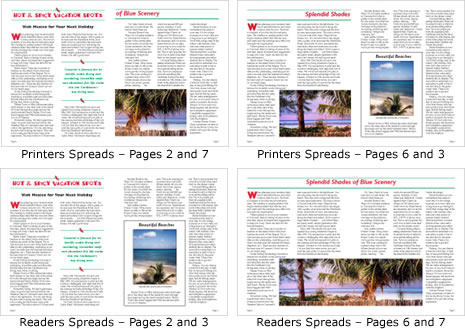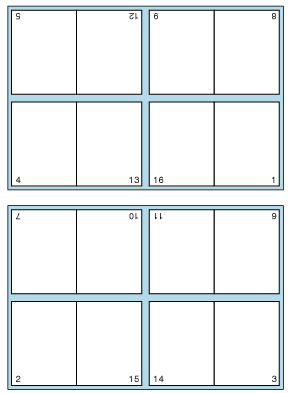
Spreads, Signatures, and Imposition
Reader Spreads
The order in which you would read the pages
of a magazine, page 1, then 2, 3, 4 and so on - is called 'reader
spreads'.
As you create a document, in a page layout program, you
arrange the pages in reader spreads.
Printer's
Spreads
Printer's spreads refers to the order in which pages are placed for
printing. When you lay out an 8 page booklet, you'd see page 1 & 8
placed together.
Signature Page:
A group of pages of a publication which are printed on both sides
of ONE sheet of paper (signature), and when folded, the printed
piece creates a set of pages.
Printing 8 pages on each side creates a 16 page signature.
The signature must be decided before beginning the
layout to be sure the total number of pages is a multiple of the
signature.
An 8 page signature can have 8, 16, 24, 32 etc. pages in the
publication.
Imposition
Arrangement of pages (printer's spread) in
the proper sequence and orientation on the press sheet/signature
to facilitate the required folding, trimming, and binding of
document.
What does "2-up printer's spread" mean?
There's two parts to this -- first the '2-up' then the 'printers
spreads'.
When printing on a printing press, often because the paper sizes can be much
larger than with desktop printers, or the paper may be on a continuous roll,
many more pages can be printed onto a single sheet.
Rather than print each actual book or magazine page on
a single sheet, many pages can be grouped together to print as many
pages as possible onto the paper in one pass.
The pages have to be arranged so that when the pages are cropped
and folded the pages actually make up the proper reading order and
this is where the '2-up' term comes from.
The 2-up means to print two pages onto a single sheet of paper, side
by side.
There are also other sizes available, such as 4, 6, 9, and 16-up.
This means you can print several pages to a larger single sheet, then
crop the sheet down to the final page size.
This whole process of arranging the maximum number of pages
to fit onto a single sheet on the press (to get as many printed in one
go as possible) and to create the printer spreads is known as Imposition.
This can get mightily complicated, when dealing with say 16-up
printing and long book documents! (I wouldn't even like to think about
32-up, 700 pages!!). Fortunately, there are impostition packages available
that automatically create the printers spreads etc.
What is important to note, is that most print shops prefer to impose their pages for printing in-house. As a designer, this is not your responsibility. You will create your pages as reader spreads, 1 or 2 up and allow the printer to determine the best imposition for the paper size and the press size.

